
Newhaven Fort is a Palmerston fort built in the 19th century to defend the harbour at Newhaven, on the south coast of England. It was the largest defence work ever built in Sussex and is now open as a museum.

The Western Heights of Dover are one of the most impressive fortifications in Britain. They comprise a series of forts, strong points and ditches, designed to protect the country from invasion. They were created in the 18th and 19th centuries to augment the existing defences and protect the key port of Dover from both seaward and landward attack; by the start of the 20th century Dover Western Heights was collectively reputed to be the 'strongest and most elaborate' fortification in the country. The Army finally withdrew from the Heights in 1956-61; they are now a local nature reserve.

Beacon Hill Battery is a ruined military fort that was built to defend the port of Harwich, Essex. It is a scheduled ancient monument.
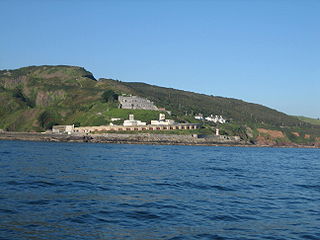
Fort Bovisand is a fort in Devon, England near the beach of Bovisand. It was built as a result of the Royal Commission on the Defence of the United Kingdom, which reported in 1860. It is located on the mainland to defend the entrance of Plymouth Sound, at the narrows opposite the east end of Plymouth Breakwater. The fort is beside Bovisand harbour.

Fort Gilkicker is a historic Palmerston fort built at the eastern end of Stokes Bay, Gosport, Hampshire to dominate the key anchorage of Spithead. It was erected between 1863 and 1871 as a semi-circular arc with 22 casemates, to be armed with five twelve-inch guns, seventeen ten-inch guns and five nine-inch guns. The actual installed armament rather differed from this. In 1902 the RML guns were replaced by two 9.2-inch and two six-inch BL guns, and before the First World War the walls were further strengthened with substantial earthwork embankments. The fort was disarmed in 1956 and used for storage until 1999, and is currently in a state of disrepair.

Whitsand Bay, situated in south east Cornwall, England, United Kingdom runs from Rame Head in the east to Portwrinkle in the west. It is characterised by sheer, high cliffs, dramatic scenery and long stretches of sandy beaches. The South West Coast Path runs the length of the bay.
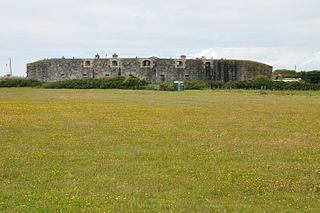
Tregantle Fort in south east Cornwall is one of several forts surrounding Plymouth that were built as a result of a decision in Lord Palmerston's premiership to deter the French from attacking naval bases on the Channel coast.
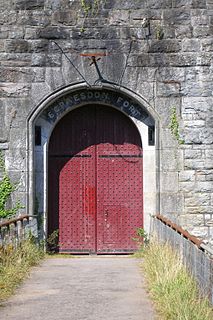
Scraesdon Fort, near the village of Antony, is one of several forts in South East Cornwall which formed part of the ring of forts surrounding Plymouth to protect Plymouth Sound and, in particular, the naval dockyard of Devonport from enemy naval attack. They were built as a result of a decision in Lord Palmerston's premiership to deter the French from attacking naval bases in the south of England.
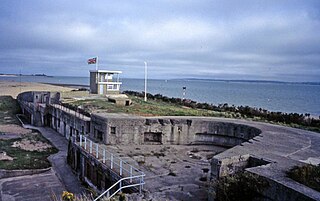
Browndown Battery, also referred to erroneously in some sources as Browndown Fort, is a former military coastal defence fortification and base on the Southern shoreline of England in the county of Hampshire. First erected in the mid-1840s, the battery was continuously modified until disarmed in 1905/6. It has been a Grade II Listed Building since 1983.

Puckpool Battery is a battery located at Puckpool Point, close to the town of Ryde on the Isle of Wight. It is one of the many Palmerston Forts built on the island to protect it in response to a perceived French invasion. Construction of the battery began in 1863 and was completed by March 1865.

Lentney Battery is a former 20th-century gun battery, built in 1905 as one of three 6-inch gun batteries to defend the Eastern approaches to Plymouth Sound, for the defence of the Royal Naval Dockyard at Devonport. It shared accommodation with the nearby Renney Battery.

Fort Efford is a former 19th-century Fort, built as a result of the Royal Commission on National Defence of 1859. It was built to defend the landward approaches to the North East of Plymouth. This was part of an overall scheme for the defence of the Royal Naval Dockyard at Devonport, Plymouth. They were known as Palmerston Forts after the Prime Minister who championed the scheme.

Forder Battery is a former 19th-century fort, built as a result of the Royal Commission on National Defence of 1859. Part of an extensive scheme known as Palmerston Forts, after the prime minister who championed the scheme, it was built to defend the landward approaches to the north east of Plymouth, as an element of the plan for the defence of the Royal Naval Dockyard at Devonport.

Watch House Battery is a former 19th-century gun battery, built as one of a number of batteries to defend the Eastern approaches to Plymouth Sound, for the defence of the Royal Naval Dockyard at Devonport.

Egg Buckland Keep is a former 19th-century fortified barracks, built as a result of the Royal Commission on National Defence of 1859. Part of an extensive scheme known as Palmerston Forts, after the prime minister who championed the scheme, it was built to defend the landward approaches to the north east of Plymouth, as an element of the plan for the defence of the Royal Naval Dockyard at Devonport. The keep was designed to house the garrison for the nearby Forder Battery, Bowden Fort and Fort Austin.
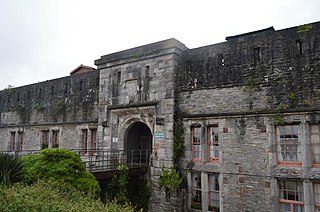
Stamford Fort is a 19th-century fort, built as a result of the Royal Commission on National Defence of 1859. Part of an extensive scheme known as Palmerston Forts, after the prime minister who championed the scheme, it was built to defend the landward approaches to the east of Plymouth, as an element of the plan for the defence of the Royal Naval Dockyard at Devonport. It is 165 feet above sea level, between Jennycliffe Bay and Hooe Lake.

The Western King's Redoubt is an 18th and 19th-century artillery battery in Plymouth, Devonshire, England, upgraded as a result of the Royal Commission on the Defence of the United Kingdom of 1859. Part of an extensive scheme known as Palmerston Forts, after the prime minister who championed the scheme, it was built to defend the seaward approaches to the Hamoaze, as an element of the plan for the defence of the Royal Naval Dockyard at Devonport.

Maker Battery is a former 19th-century coastal artillery battery, built to strengthen the defence of the Royal Naval Dockyard at Devonport.

Raleigh Battery is a former coastal artillery battery, built to defend the Royal Naval Dockyard at Devonport.

Hawkins Battery is a former coastal artillery battery, built to defend the Royal Naval Dockyard at Devonport.


















